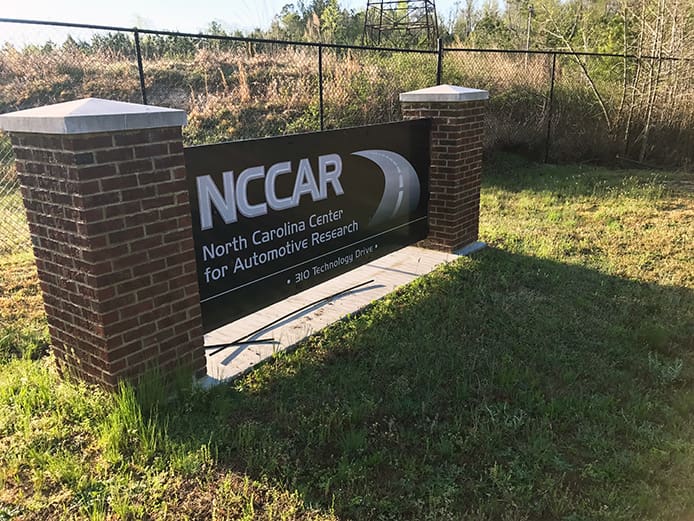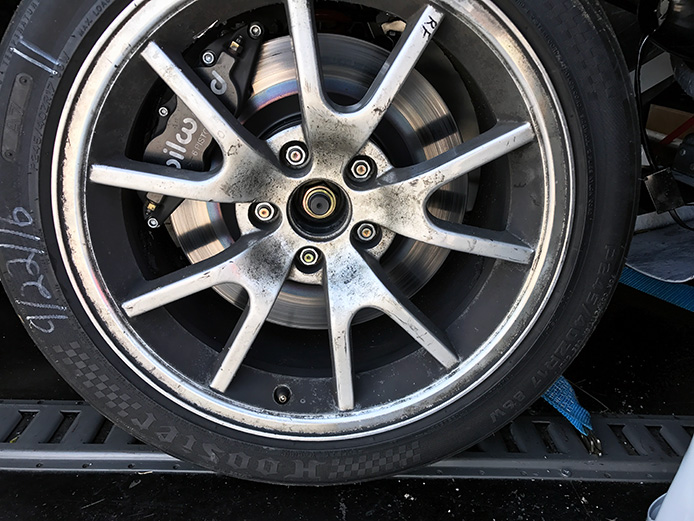
Over the last month we have been testing the new Gen 3 Type 65 Coupe model using two test cars, namely the latest factory-built car and the beta version owned by customer John George. John’s car was built to compete in the NASA ST2 class. The goal of our wind tunnel testing was to establish baseline aerodynamic data on the new Coupe body and determine optimized balanced downforce and then verify this on the track. With the cold weather and the tracks in the Northeast still closed for the winter, we headed south to North Carolina for a full day of wind tunnel testing in Mooresville, NC and then off to the North Carolina Center for Automotive Research to run the car on the test track.

We loaded up the Coupe on Saturday for the Monday test day at A2 Wind Tunnel

We arrived Mooresville, NC at A2 Wind Tunnel in the afternoon on Sunday. Day one of the testing started out with us unloading at the A2 wind tunnel in Mooresville, NC. This is the same tunnel we have used several times before and one of three we have used over the years. The crew at A2 always gives us their best and helps get the most data from the time spent.

Above & Below: The A2 Wind Tunnel is used by NASCAR teams and race professionals all year long.



Initial testing was with the stock vehicle at street ride height.

Overall we were able to run 37 different tests in the wind tunnel, starting from a baseline and then maximizing the downforce and measuring the effects of the individual pieces and how they balance the car out. One very important factor in this testing was that the car had already been tested on track at speed, which gave us a good setup starting point that we knew had a good aerodynamic balance front to rear going into the test, this allowed us to not just maximize the total downforce, but maximize the front and the rear in relation to what we knew was a working setup. As has been the case with every one of the previous four trips to the wind tunnel some of the results were as expected and some were more surprising.


What we tested:
- 3 different rear wings+ one rear spoiler
- 2 sets of canards
- Various splitter mounting depths
- Front and rear fender ducts
- GTM style hood louvres
- Ride height and rake changes
- 818 style diffuser
- Race nose on and off and with and without splitter
- Rear quarter windows on and off and flush rear quarter windows
- Rear wing angles

Results:
Our goal was to collect as much data as we could about each individual part installed on the car and then find balanced set-ups that combine the parts or settings to get the most out of the car for any given setup. What we found:
- The hood vents as tested did not noticeably affect downforce
- The fender air release vents made a small but measureable difference in downforce These vents are likely more effective than measured due to the wheels not spinning during the test
- The rear quarter windows are mostly out of the airflow and do not produce much drag however they do affect airflow to the wing and hurt overall downforce
- Flush quarter windows were not an improvement in drag or downforce over no quarter windows at all
- The 818 Diffuser with a smooth curved lead up did not add significant downforce or affect drag (this could be due to the floor of the wind tunnel however the diffuser did work on the 818 in this tunnel)
- The front race nose without any other add-ons produced significantly less drag than the street nose.
- The lower the nose was run the more downforce and less drag the car made
- Both sets of canards were equally effective but with more drag penalty than the splitter
- The splitter made significant downforce with very low drag penalty.
- The GT1000 wing from APR was the most efficient design we tested and made the most downforce, for the same drag the downforce increase was significant.
- Mounting the rear wing and the rear street spoiler made more downforce than the wing alone but with a major drag penalty

We determined that three (3) baseline setups made sense based on the parts combinations for track use:
Combo #1: Street rear spoiler, race nose, street ride height, no other add-ons.
For the occasional track car that still sees street duty, or in order to maintain a more period look this is a nice balance of low drag and a modest amount of useable down force.
Combo #2: GT300 rear wing, race nose, splitter, race ride height.
For a track day car with good balance and adjustability and without going all out on the aero. Splitter should be mounted with 3-3.5 inches visible sticking out from the nose.
Combo #3: GT1000 rear wing, race nose, splitter, upper and lower canards, front and rear fender vents.
For ultimate performance with plenty of adjustment in the rear wing. Car should be run at 3 inch ride height or below and with heavy rate springs to account for the downforce. Splitter mounted 4.5- 5 inches sticking out from race nose. Wing angle between 1 and 2 degrees to start.

NCCAR Track Testing:
We took our wind tunnel data to the track the following day and headed east to one of our favorite places to test, North Carolina Center for Automotive Research (NCCAR). This is a facility designed specifically for vehicle testing and a track designed to have a little bit of everything as far as the shape and speed of the turns. Once we unloaded the car we had to swap from the wind tunnel set-up to the track setup. In order to allow for ride height adjustments and any other changes needed to the suspension for the tunnel (there is a specific ride height adjustment to account for the thickness of the tunnel sensors) we had a second full set of coil-overs that had been scaled and set to go for the track. To begin the day we swapped out to the track suspension, set up the car on our race tires, torqued the wheels and set the baseline pressures. All of our aero parts were set back to the balanced set-up point from the previous road course test except the splitter was left at the more aggressive 5 inch distance.

Goals for the track test:
- Find a balanced spring/shock/antiroll bar setup
- Find the maximum downforce setup that was still balanced
- Prepare the car for the Ultimate Track Car Challenge on May 19
- Optimize braking via bias and minimize knockback
- Dial in dual adjustable Koni shocks
- Find a good baseline suspension setup for the full aero car

We began the test by running the car through a few installation laps and then rechecking tire pressures, and giving the car a quick visual check then we started the real testing. With the front splitter being so aggressive we started with adjustments on the rear wing to try and get the car back to a balanced setup. With the double canards and the splitter extended we ended up right at about the max angle on the rear GTC300 wing. The spring combo that had been found to work best at the previous event was working well so we left it in place, 900lb front and 700lb rears springs (rear is 2015 IRS) the sway bars were set to full stiff front and medium stiffness rear.

We had installed knockback springs in the rear calipers between tests and these had cured about 90 percent of the pad knockback (where the brakes can push the master cylinders back in in hard turns and cause a soft pedal) so we moved on to testing the shocks. This car was set-up with the double adjustable Koni coil-overs and a call in to their race engineer had given us a baseline setting to start from so starting from 5 clicks of compression and 2/3 sweeps of rebound on the front and rears we started to test adjustments. Running a few laps at a time we gradually raised rebound until the car started to get noticeably harder to drive, we then removed the shocks and adjusted up one click of compression all around, but found that was not making the car feel better or go quicker.
Once we had run through all of our testing we packed up and went back to analyze the data from Racepak and all the feedback recorded from the driver after each session.

Set-up Conclusions:
- For the full aero set-up 900 front 700 rear is a good starting point
- The lower the car can be set-up the better so long as the chassis isn’t bottoming, with the stiff springs but shocks on soft this was still an issue at the track with larger curbing.
- For the max front aero setting the GT1000 wing gives the best balance and adjustability
- With the higher rear weight bias of the coupe (as compared to the challenge cars) it like more rear tire than in the front so a split like 295/315 or 305/335 is preferred to a square setup
- For shock setting on the Koni 3012s we settled on 5 licks of compression and 5 sweeps of rebound all around as a good baseline. These shocks are being phased out so we will convert this to the new style when they are released.
- The g-forces on the chassis from this level of cornering are significant enough to make oil and fuel control a much bigger issue than in a non-aero car. A dry sump oiling system and a fuel cell with check valve style pickup should be considered.
- The aero “balance” found in the wind tunnel and on the track will not be a direct correlation, so adding the same amount of downforce to the front and rear may not (likely will not) maintain the same balance. Instead know which parts add more or less and how efficiently will allow the best set-up to be found.





















